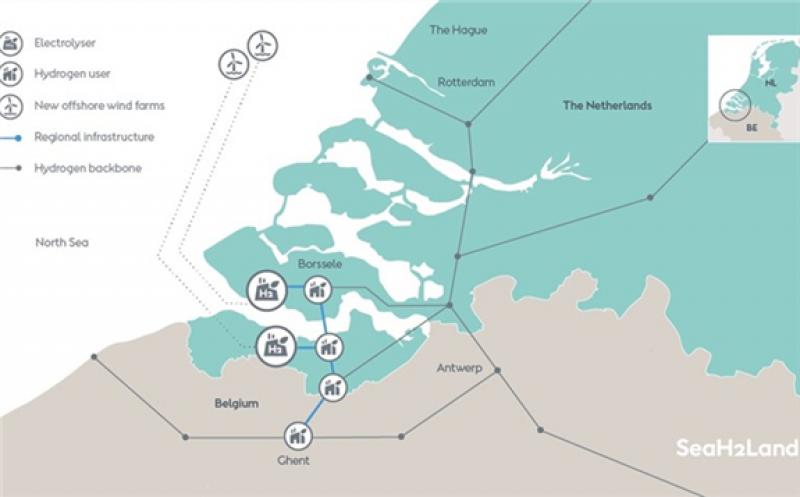Orsted is to develop one of the world’s largest renewable hydrogen plants to be linked to industrial demand in the Netherlands and Belgium

'SeaH2Land' aims to link GW-scale electrolysis to the large industrial demand in the Dutch-Flemish North Sea Port cluster through an envisaged regional cross-border pipeline.
The green electricity required to produce the renewable hydrogen is proposed to come from the build-out of additional large-scale offshore wind.
The major industrial companies in the region ArcelorMittal, Yara, Dow Benelux, and Zeeland Refinery, will support the development of the required regional infrastructure to enable sustainably-produced steel, ammonia, ethylene, and fuels in the future, helping the Netherlands and Belgium to accelerate their carbon reductions towards 2030 and beyond.
The SeaH2Land vision includes a renewable hydrogen production facility of 1GW by 2030 to be developed by Orsted.
If realised, the electrolyser, which will produce the renewable hydrogen, can convert about 20% of the current hydrogen consumption in the region to renewable hydrogen.
With 580,000 tonnes per year, the North Sea Port cluster is one of the largest production and demand centres of fossil hydrogen in Europe today.
Driven by decarbonisation efforts, industrial demand in the cluster could grow to about 1,000,000 tonnes by 2050, equivalent to roughly 10GW of electrolysis.
Orsted proposes to connect the GW electrolyser directly to a new 2GW offshore wind farm in the Dutch North Sea.
This will enable the large-scale supply of renewable electricity required for production of renewable hydrogen and fits well with the ambitions of the Dutch authorities for an accelerated offshore wind roll-out in line with increasing electricity demand.
The offshore wind farm could be built in one of the zones in the southern part of the Dutch exclusive economic zone that has already been designated for offshore wind development.
The industrial players in the region, united in the Smart Delta Resources (SDR) industry partnership, will continue the dialogue with TSOs for them to develop a regional open-access pipeline network of about 45km, stretching across the North Sea Port area from Vlissingen-Oost (NL) to Gent (BE).
The GW electrolyser is proposed to link to the envisaged regional pipeline system connecting large-scale consumption and production in the cluster.
Yara, in consortium with Orsted, and Zeeland Refinery have each announced plans for mid-size renewable hydrogen production at their sites, while Dow has been exporting hydrogen to Yara since 2018 through the world's first conversion of a gas pipeline into hydrogen.
Moreover, the cluster strategy proposes to extend the 380 kV high-voltage network for the electrification needs of the industry south of the river Scheldt.
This would enable GW-sized electrolysis and offshore wind landing zones on both sides of the river, turning the cluster into a true energy hub.
Subject to a regulatory framework being in place, the regional network will unlock the first phase of SeaH2Land, which comprises 500MW of electrolyser capacity.
The second phase of SeaH2Land which scales the electrolyser capacity to 1GW will require the possibility to connect to a national hydrogen backbone, providing additional flexibility and storage.
Several locations north and south of the river Scheldt have been identified for GW-scale electrolysis.
In the meantime, several projects are being developed in the region on the sites of industrial players, such as Zeeland Refinery's envisaged 150MW electrolyser, which are also to be connected to the network.
The partnership will now move forward and engage in dialogue with the regulatory authorities on the framework and policies needed to support the development of renewable hydrogen linked to large-scale offshore wind, the regional infrastructure, and conduct a full feasibility study of the project.
Orsted chief commercial officer and deputy group chief executive Martin Neubert said: "The Dutch-Flemish North Sea Port covers one of the largest hydrogen clusters in Europe.
"As the world looks to decarbonise, it's paramount that we act now to secure the long-term competitiveness of European industry in a green economy.
"The SeaH2Land project outlines a clear vision and roadmap for large-scale renewable hydrogen linked to new offshore wind capacity.
"With the right framework in place, the Netherlands and Belgium can leverage the nearly unlimited power of offshore wind to significantly advance renewable hydrogen as a true European industrial success story."